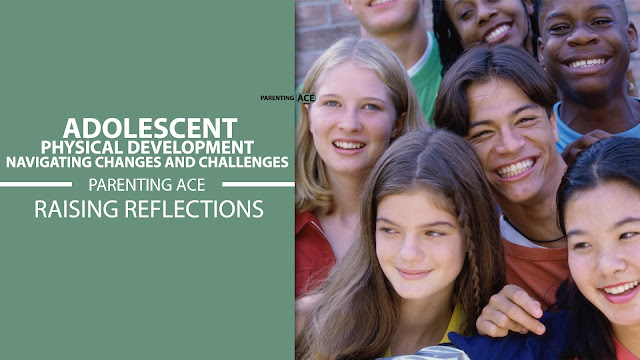Adolescence: Navigating Changes and Challenges in Physical Development
In the whirlwind of adolescence, physical changes often take center stage, shaping not only the outward appearance but also the inner landscape of emotions and self-perception. As parents, navigating this transformative period with our children demands sensitivity, understanding, and unwavering support. In this blog post, we delve into the intricacies of adolescent physical development, exploring the challenges it poses and offering invaluable parenting strategies to guide our children through this journey of self-discovery and growth. Join us as we embark on a quest to nurture resilience, foster body positivity, and empower our adolescents to embrace their evolving selves with confidence and grace.
 |
| Adolescent Physical Development: Navigating Changes and Challenges |
Adolescence marks a significant phase in a child's life, characterized by rapid physical, cognitive, and emotional changes. As parents, navigating these transformations can be both rewarding and challenging. Understanding the intricacies of physical development during adolescence is crucial for providing appropriate support and guidance to our children. In this article, we explore the nuances of adolescent physical development, the challenges it presents, and effective parenting strategies to help adolescents navigate this transitional period with confidence and resilience.
The Dynamics of Physical Development
During adolescence, children undergo a myriad of physical changes driven by hormonal fluctuations and growth spurts. These changes include rapid height and weight gain, development of secondary sexual characteristics, such as breast development in girls and facial hair growth in boys, and neurological developments that influence coordination and motor skills. These transformations are not only visible but also impact adolescents' self-perception and body image, shaping their sense of identity and self-esteem.
Challenges and Concerns
While physical development during adolescence is a natural and necessary process, it can also pose challenges and concerns for both adolescents and their parents. Adolescents may experience feelings of self-consciousness, insecurity, and peer pressure as they navigate these changes, leading to body image issues, unhealthy eating habits, and risky behaviors such as substance abuse or disordered eating. Moreover, the onset of puberty may result in mood swings, heightened emotions, and conflicts with parents as adolescents strive for independence and autonomy.
Parenting Strategies
As parents, supporting adolescents through their physical development requires empathy, communication, and patience. Here are some effective parenting strategies to navigate this journey:
- Open Communication: Foster open and honest communication with your adolescent, creating a safe space for them to express their thoughts, feelings, and concerns about their changing bodies. Listen actively without judgment and offer reassurance and guidance when needed.
- Promote Healthy Habits: Encourage healthy lifestyle choices, including balanced nutrition, regular exercise, and adequate sleep, to support physical development and overall well-being. Be a role model by demonstrating these habits in your own life.
- Validate Feelings: Validate your adolescent's feelings and experiences, acknowledging the challenges they may face during this transitional period. Offer empathy and understanding, reassuring them that it's normal to feel uncertain or self-conscious about their changing bodies.
- Set Realistic Expectations: Set realistic expectations for physical development, recognizing that every adolescent progresses at their own pace. Avoid comparing them to their peers or unrealistic societal standards, emphasizing individual growth and self-acceptance.
- Foster Body Positivity: Promote body positivity and self-love by celebrating diversity and emphasizing the importance of inner qualities over external appearance. Encourage your adolescent to appreciate their body for its strength, resilience, and uniqueness.
Navigating the changes and challenges of physical development during adolescence requires patience, understanding, and active involvement from parents. By fostering open communication, promoting healthy habits, validating feelings, setting realistic expectations, and fostering body positivity, parents can support their adolescents in navigating this transformative period with confidence, resilience, and a strong sense of self-worth. Together, let us embrace the journey of adolescence and empower our children to embrace their physical selves as they journey towards adulthood.




